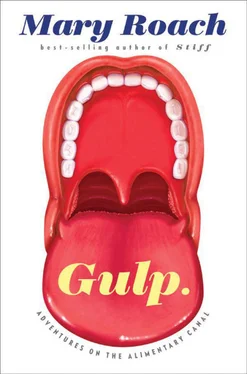OWING TO THE limited talents of the colon as an organ of absorption, perfectly good nutrients are daily discarded. The small intestine has time to absorb only so much before passing the goods along to the colon. Bacteria in the colon break down what they can, creating vitamins and other nutrients in the process, but because the colon isn’t as well set up to absorb the locally produced bounty, some of it is excreted.
This topic came up during a conversation with pet-food scientist Pat Moeller, of AFB International (and chapter 2). Moeller had offered an explanation for the disconcerting canine habit of autocoprophagia. “If you think about it”—and, improbably, we were—“a dog that eats its stool, in some cases, may be getting missing nutrients” by running a meal through the small intestine twice.
In some neighborhoods of the animal kingdom, your own is a regular second course. For rodents and rabbits, in whom vitamins B and K are produced exclusively in the colon (by bacteria that live there), the self-manufactured pellet is a large, soft daily vitamin. Which brings us to Richard Henry Barnes and a little-known chapter of nutrition history.
Richard Henry Barnes was the dean of the Graduate School of Nutrition at Cornell University from 1956 to 1973, the president of the American Institute of Nutrition, and the first academic to formally address the consumption of shit. I found a photograph of Barnes taken around the time his “Nutritional Implications of Coprophagia” ran in Nutrition Reviews . His blond hair had receded from his temples and was combed flat against his skull. His glasses were the two-toned horn rims popular in the late 1950s. Ed Harris could play the part. Barnes did not appear to be in any part an iconoclast. “One of the qualities I respected most in Dick,” a colleague reminisced in a Barnes obituary, “was his complete open-mindedness and objectivity in dealing with… socially and politically sensitive questions.”
Barnes’s original interest in rodent autocoprophagia grew out of efforts to prevent it. Like other nutritionists of his day, Barnes was frustrated to find his carefully controlled diet studies repeatedly undone by his subjects’ menu substitutions. Experimenters before him had tried building cages with wire-mesh flooring that allowed fecal pellets to drop through. This proved to be of limited use because, quoting Barnes, “feces are consumed as they extrude from the anus.” Rats on mesh floors still managed to consume anywhere from 50 to 65 percent of their “total output.”
Presently Barnes became more interested in the inputting of output than in the elements of nutrition he’d originally set out to study. “The contributions of coprophagy in rats as a means of making available the nutrients that are synthesized in the lower intestine has remained one of the major nutritional mysteries of our time,” he wrote in a 1957 paper funded by, holy shit, the National Science Foundation (NSF).
Barnes began by documenting the precise extent to which egesta made up his rats’ daily fare. This he did by fashioning “feces collection cups” from the necks of small plastic bottles and fitting them over the rat’s tail and rear end. And here we get a glimpse of the industriousness and creativity of Richard Henry Barnes. Part of that NSF grant went to cover the cost of a band saw, Forstner drill bit, wood chisel, Scotch tape, metal bands, rubber tubing, and three different sizes of plastic bottles from the Wheaton Plastics Company. Daily collections were emptied from the cup and served to the animal in its feed jar, which I like to picture with a silver warming cover, lifted with a flourish by Barnes himself. The rats, Barnes found, ate 45 to 100 percent of what they’d excreted each day. If you prevent a rat from doing this, Barnes further noted, it will quickly become deficient in vitamins B5, B7, B12, and K, thiamine, riboflavin, and certain essential fatty acids.
Four years later, B. K. Armstrong and A. Softly, scientists with the Department of Biochemistry and the Animal House at Royal Perth Hospital, showed that preventing rats from eating their first round of excreta severely stunted their growth. Over the course of a forty-day experiment, young rats thusly stymied gained just 20 percent of their starting body weight, while an unhindered control group gained 75 percent. (Both groups ate all their other food as well.) Armstrong and Softly developed their own unique method of restraint, eschewing the Barnes technique. “To eliminate the necessity for continual emptying and replacement of fecal cups, we have used a jacket to prevent the rat from reaching its anus.”
“Used a jacket” is a humble understatement. A pattern (included in the journal paper) was drawn up and soft purse leather purchased. “A V-shaped tail cleft was trimmed to clear the penis or vagina. The laces were adjusted to give a firm, but not tight fit, and the string was tied at the tail in a knotted bow. Final adjustments were made with fine scissors.” It all sounds very Stuart Little until you turn the page and come upon plate 1: “Rats wearing jackets to prevent coprophagy.” The leather is black, and the jacket, actually a vest, is laced along the animal’s midline like a corset. An attached black leather collar completes the look. Suddenly “restraint” took on a whole new flavor, and you began to wonder what went on after hours at the Animal House.
Barnes likened autocoprophagia to rumination: another strategy to get the most out of one’s meal. Cows will rechew and reswallow the same mouthful forty to sixty times, greatly increasing the surface area that rumen bacteria have to work with and extracting maximum nutritive value. In fact, one of the alternate terms for autocoprophagia is “pseudo-rumination.” No doubt the word was coined by a rabbit fancier. Rabbits are diehard autocoprophagics, and their owners seem a little uncomfortable with it. In rabbit circles, the first round’s larger, softer fecal pellets [108] Given the situation with rabbits and their fecal pellets, you would think the producers of commercial rabbit food would have steered clear of the word pellets. When, say, the Kaytee brand boasts, “Quality, nutritious ingredients in a pellet diet that rabbits love,” I don’t necessarily picture a bag of kibble.
have a special, non-fecal-sounding name: cecotropes. “Cecotrophy, not Coprophagy,” tuts a heading in one journal paper.
“It seems likely that most nonruminant species have a voracious appetite for feces,” Barnes bravely continued. “This practice is so normal to their nutritional behavior that the… large intestine should rightfully be considered as functionally positioned ahead of the absorptive region of the intestinal tract.” In other words, a second visit to the small intestine is the true end point for absorption.
I will buy that autocoprophagia is, as Barnes put it, “a normal practice for… rats, mice, rabbits, guinea pigs, dogs, swine, poultry, and undoubtedly many others.” But Richard: “Most nonruminant species”?
Let’s check in first with our closest cousins. I e-mailed Jill Pruetz, the Iowa State University primatologist whose work with chimpanzees in the Fongoli River region of Senegal I profiled for a magazine in 2007. By coincidence, Pruetz and her colleague Paco Bertolani had just submitted a paper on the topic. “I don’t like to think of the Fongoli chimps as shit-eaters,” she wrote back, “but what are you going to do?” For one thing, you call it “seed reingestion.” Technically speaking, this is accurate. Fongoli chimps don’t, as they say, “consume the dung matrix.” They “excrete a faecal bolus into one hand and then extract the seeds from it with the other hand or with the lips.” You may be pleased to note that when they are done they “clean their lips by rubbing them on the bark of trees.”
Читать дальше












